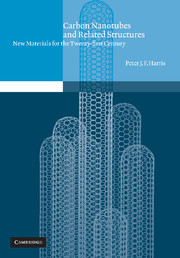Book contents
- Frontmatter
- Contents
- Acknowledgements
- 1 Introduction
- 2 Synthesis: Preparation methods, growth mechanisms and processing techniques
- 3 Structure
- 4 The physics of nanotubes
- 5 Nanocapsules and nanotest-tubes
- 6 The ultimate carbon fibre? The mechanical properties of carbon nanotubes
- 7 Curved crystals, inorganic fullerenes and nanorods
- 8 Carbon onions and spheroidal carbon
- 9 Future directions
- Name index
- Subject index
1 - Introduction
Published online by Cambridge University Press: 28 January 2010
- Frontmatter
- Contents
- Acknowledgements
- 1 Introduction
- 2 Synthesis: Preparation methods, growth mechanisms and processing techniques
- 3 Structure
- 4 The physics of nanotubes
- 5 Nanocapsules and nanotest-tubes
- 6 The ultimate carbon fibre? The mechanical properties of carbon nanotubes
- 7 Curved crystals, inorganic fullerenes and nanorods
- 8 Carbon onions and spheroidal carbon
- 9 Future directions
- Name index
- Subject index
Summary
Take Carbon for example then
What shapely towers it constructs
A. M. Sullivan, Atomic ArchitectureCarbon, in fact, is a singular element …
Primo Levi, The Periodic TableThe ability of carbon to bond with itself and with other atoms in endlessly varied combinations of chains and rings forms the basis for the sprawling scientific discipline that is modern organic chemistry. Yet until recently we knew for certain of just two types of all-carbon crystalline structure, the naturally occurring allotropes diamond and graphite. Despite the best efforts of some of the world's leading synthetic chemists, all attempts to prepare novel forms of molecular or polymeric carbon came to nothing: the elegant allcarbon structures proposed by Roald Hoffmann, Orville Chapman and others remained firmly in the realm of pure speculation. Ultimately, the breakthrough which revolutionised carbon science came not from synthetic organic chemistry but from experiments on clusters formed by the laser-vaporisation of graphite.
Harry Kroto, of the University of Sussex, and Richard Smalley, of Rice University, Houston, had different reasons for being interested in the synthesis of carbon clusters. Kroto had been fascinated since the early 1960s in the processes occurring on the surfaces of stars, and believed that experiments on the vaporisation of graphite might provide key insights into these processes. Smalley, on the other hand, had been working for several years on the synthesis of clusters usinglaser-vaporisation, concentrating chiefly on semiconductors such as silicon and gallium arsenide. But he was also interested in what might happen when one vaporises carbon.
- Type
- Chapter
- Information
- Carbon Nanotubes and Related StructuresNew Materials for the Twenty-first Century, pp. 1 - 15Publisher: Cambridge University PressPrint publication year: 1999
- 1
- Cited by



